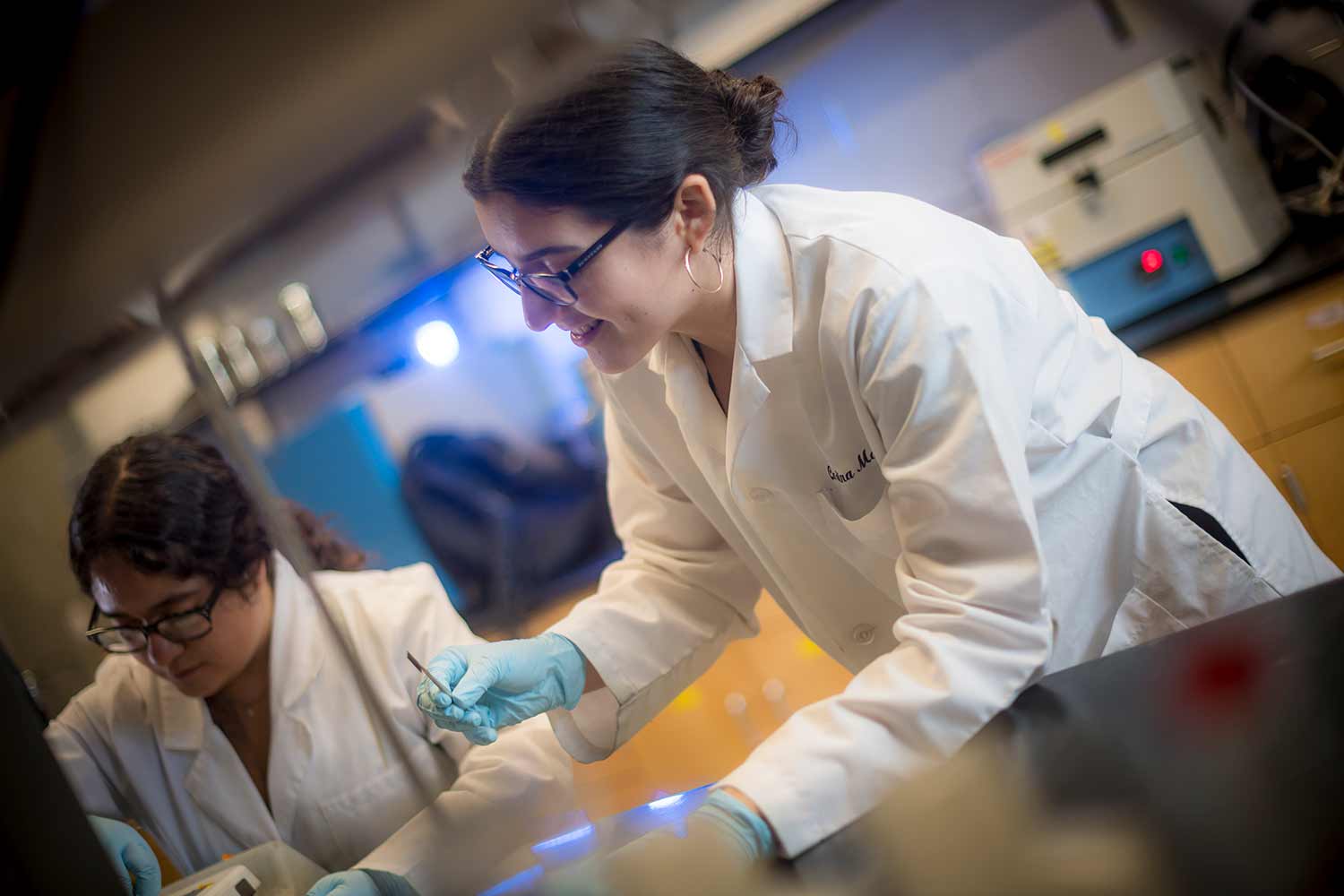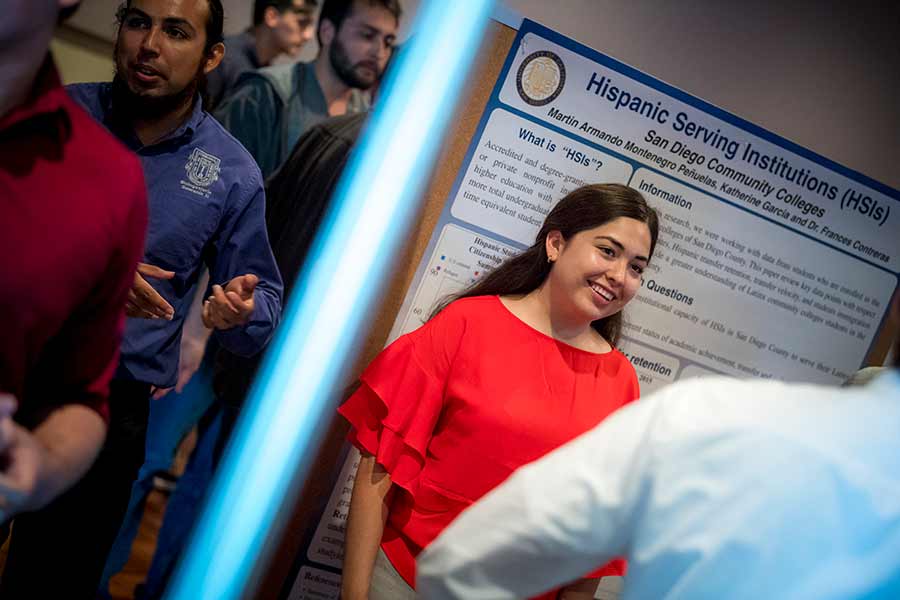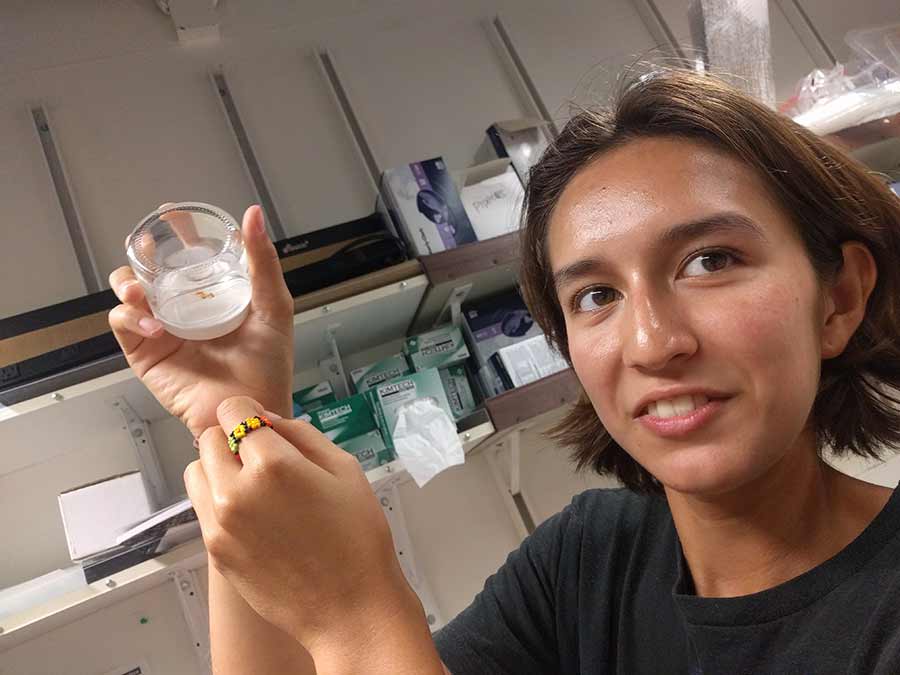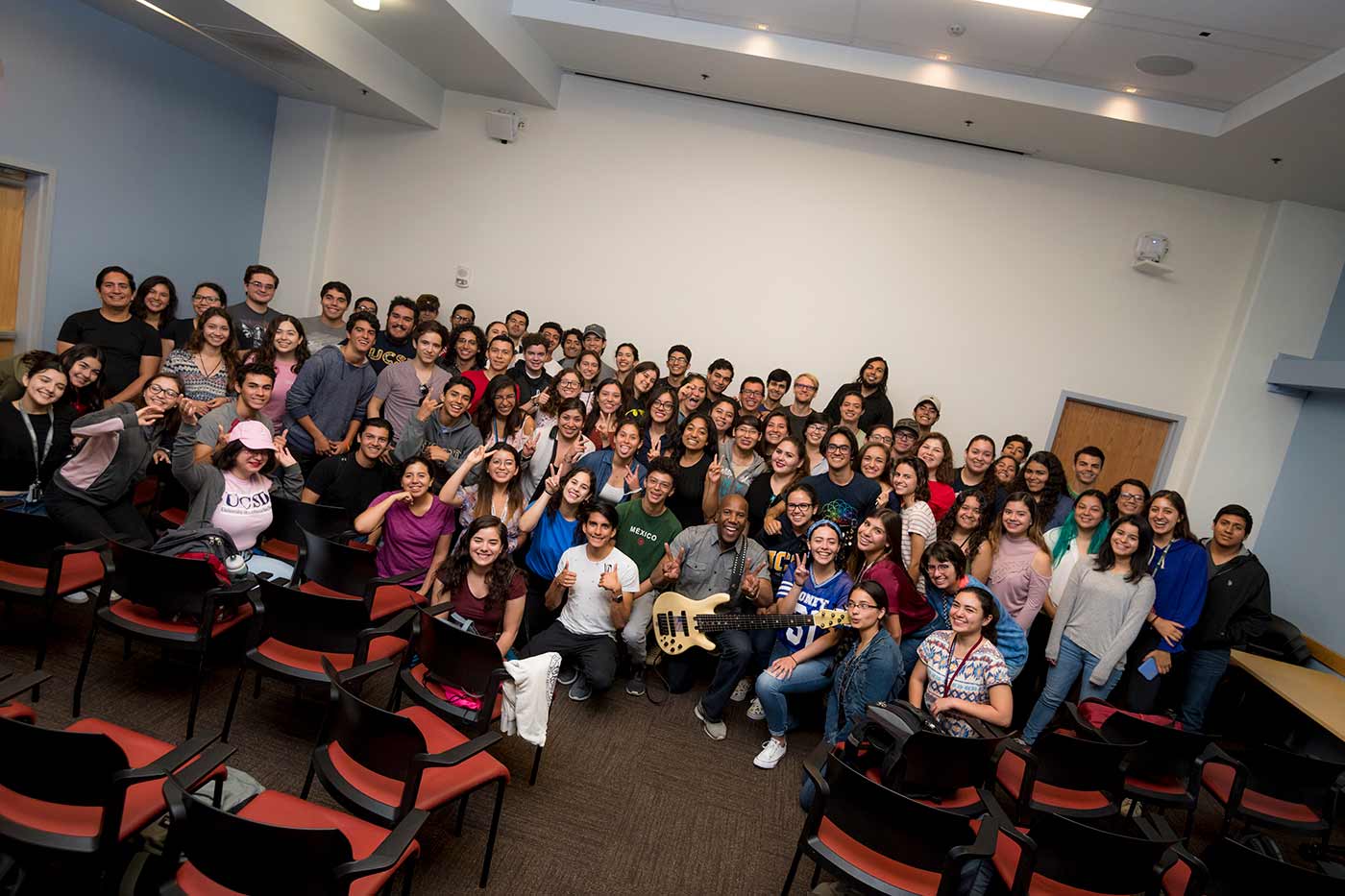
By:
- Katherine Connor
Published Date
By:
- Katherine Connor
Share This:

From left, Angela Mendez and Carolina Martinez working together to develop a thermo-responsive polymer switching film to coat lithium-ion batteries and keep them from overheating. Mendez goes to school in San Diego, while Martinez is from Tijuana. Photo by Erik Jepsen/UC San Diego Publications
Building Bridges and Batteries
High school students Angela Mendez and Carolina Martinez spent seven weeks at UC San Diego working side by side in nanoengineering professor Zheng Chen’s lab developing a coating that could protect lithium-ion batteries from overheating and catching fire. They learned how batteries work; what it means to conduct research; what it’s like to be an engineer; and experienced life as a college student.
While they were helping build batteries, they were also building bridges between the United States and Mexico: Mendez attends high school in San Diego, while Martinez is a student in Tijuana. They were two of more than 100 high school and college students from both sides of the border who spent their summer at UC San Diego in the ENLACE program, building professional and personal connections across the border through science and engineering.
“Science is universal,” said Olivia Graeve, a professor of mechanical and aerospace engineering at UC San Diego’s Jacobs School of Engineering. Graeve is a Tijuana native and Jacobs School alumna herself. She started ENLACE, which means “link” in Spanish, six years ago. “The intent of ENLACE is to have the students build these human bridges across the border, using science and engineering as a tool to get them to engage, know each other and participate in the development of knowledge that will benefit both sides of the border.”

The 108 high school and college students in the ENLACE program this year presented their research in a closing symposium that featured oral and poster presentations.
During summer 2018, the students worked in pairs—usually one student from the U.S. and one from Mexico—in 60 labs all across campus, in fields including nanoengineering, physics, marine biology, computer science, psychology, bioengineering, ophthalmology, mechanical engineering and more. In addition to conducting research on pressing scientific questions, they learned how the school systems in the two countries compare; heard from respected community leaders in a weekly Science and Society lecture series; honed their public speaking skills for a final presentation; and bonded over the similarities and differences between their backgrounds.
Martinez and Mendez both cross back and forth between the U.S. and Mexico regularly—usually several times a week—to visit family, go shopping or go to the movies. While they knew a lot about both cultures, Martinez said she valued learning how the U.S. education system works, since she would like to pursue a degree in bioengineering or biochemistry here.
“It’s nice because Angela is more familiar with the American school system in comparison with me, and since I want to study here, we talk a lot about schools and universities and stuff,” Martinez said. “My main reason to come here was I wanted to get actual experience—I would always think I want to be this, I want to do that for a career, but since I didn’t have any firsthand experience, I didn’t really know. Working in an actual, professional lab has been something totally different than my past experience. It’s amazing.”
For other ENLACE participants, like National Autonomous University of Mexico (UNAM) computer engineering student Sebastian Silva, this was the first time they’d been to the U.S. Silva spent the seven weeks of the program in Computer Science and Engineering Professor Tajana Rosing’s lab, working on a machine learning platform to better understand how the brain works and classifies data. In addition to a new experience in the U.S., Silva said he liked that Rosing’s lab itself was very diverse, with members from all around the world.

Jessica Garcia, a high school senior from Ensenada, holding a specimen of a ghost crab. She spent her summer in assistant professor Jennifer Taylor’s lab at the Scripps Institution of Oceanography researching how ghost crabs communicate.
“I’ve always been curious what America is like, how the people are and what they like,” Silva said. “I’ve visited a few countries but would like to visit more. But there are a lot of people here, even from Mexico, that I wouldn’t have ever known if I didn’t come here, because I’ve never visited the northern part of Mexico.”
Jessica Garcia, a high school senior at the Center for Technical and Higher Education (CETYS) in Ensenada, was a student in Professor Jennifer Taylor’s lab at the Scripps Institution of Oceanography, studying how ghost crabs communicate. She thought she might want to study marine biology in college, and the ENLACE experience reinforced that, but clarified some misconceptions, too.
“The thing that most surprised me about research is that it involved a lot more than I thought it would,” Garcia said. “You are working with the animals and you are taking the data and doing the fun stuff, but then you also have to do the work before all of that—setting up the containers, processing and planning so animals don’t get out. Having to think about all the hypothetical situations was interesting.”
Science and Society
Graeve grew up in Tijuana and decided in high school to become an engineer while helping refugees from southern Mexico build shelters, dig latrines and create a livable infrastructure. She figured becoming an engineer would give her tools to do this more efficiently. She studied structural engineering at UC San Diego, and even as a student, she thought the bi-national region was missing out on an opportunity.
“I am a cross-border person and I am a citizen of both countries. I was very used to crossing the border for many reasons, but I was not used to scientific interactions on both sides of the border. And when I was growing up and I was an undergraduate that was missing. But now I think that shared, collaborative innovation is happening, and this program in particular I feel is contributing to that.”
Graeve, who Forbes named one of Mexico’s 100 Most Powerful Women in 2017, has made significant contributions to this end as an expert on nanomaterial development for use in extreme environments. In fact, many students participate in the program because they so respect her.
“I study in Tijuana and Dr. Graeve gave a talk at the Tijuana Institute of Technology,” said Brenda Araiza, an aerospace engineering student and ENLACE participant who spent the summer in Professor Shelley Wright’s Center for Astrophysics and Space Sciences. “All the girls from my class were really excited because to see a women be very successful in engineering was awesome. In my class there were 40 students, but only five girls. So the five of us were really excited.”

ENLACE students were treated to a jam session with UC San Diego alumnus Nathan East, who’s played the bass for musicians like Beyonce, Eric Clapton and Michael Jackson. East shared his story and advice with the students as part of the Science and Society lecture series.
Graeve has also earned the respect of some high-profile people, to the benefit of ENLACE students. Speakers in the Science and Society lecture series included City Attorney Mara Elliot, whose mother immigrated to the U.S from Mexico as a teenager; Judge Gonzalo Curiel, who presided over the Trump University case and the Arellano-Felix cartel case resulting in the first extradition of a Mexican to the U.S. to face criminal charges; and Nathan East, a UC San Diego alumnus and world-renowned bassist who’s played with Eric Clapton, Stevie Wonder, Beyoncé, Daft Punk and Michael Jackson.
While peripheral activities of the ENLACE program like these lectures and field trips on the weekends to the San Diego Zoo, beaches and other San Diego landmarks have grown over the past six years, Graeve says the core of the program always has and will be research.
“I think we all have something to contribute to the development of technologies and the development of science and engineering,” she said. “Putting barriers and blocks is not going to promote that kind of interaction that I think is very positive. And for me it goes beyond that—I’m not just thinking of bringing talented minds to the United States, I’m thinking of U.S. people also going down to Baja California. So it is now a relationship of equals and a relationship of reciprocity. This program can promote those kinds of exchanges in the science and engineering fields.”
Martinez and Mendez are still early in their engineering careers, but perhaps the friendship developed by two ambitious students in the lab this summer as they built batteries will have national and binational effects.
Share This:
You May Also Like
Stay in the Know
Keep up with all the latest from UC San Diego. Subscribe to the newsletter today.


